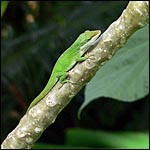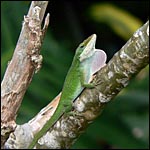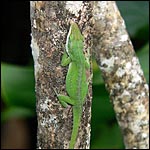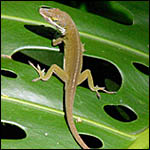Gold Dust Day Gecko
Native to Madagascar. The population in Hawaii is descended from eight individuals released by a student at the University of Hawaii, Manoa in June 1974.
Common House Gecko
Common House Geckos are believed to have arrived in Hawaii during or just after World War II. It is a native of southeastern Asia and the northern parts of Africa.
Mourning Gecko
The Mourning Gecko is thought to have arrived as a stowaway aboard the early Polynesian voyaging canoes.
Stump-toed Gecko
The Stump-tailed Gecko is thought to have arrived as a stowaway aboard the early Polynesian voyaging canoes.
Tree Gecko
The Tree Gecko may have rafted to the Hawaii on debris or arrived with the early Polynesians. This is the smallest species of gecko in Hawaii.
Indo-Pacific Gecko
This gecko is found on many islands in the western Pacific and probably arrived in Hawaii with the early Polynesians. This is a parthenogenic species composed only of females.
Green Anole
 |
 |
 |
 |
|
| |
Territorial display showing dewlap |
|
|
|
Native to the Southeast part of the U.S. First observed in on Oahu in 1950 and thought to have its origin from the release of imports of pets. The green anole is so named because it is usually bright green, though it can shift to brown when it is cold or socially stressed.
Brown Anole
Native to Cuba, Jamaica and the Bahamas. This species is more aggressive than the Green Anole and is a much faster runner. It is relatively common in dryer lower elevations and was first observed on Oahu in the late 1970s. This individual is the first one observed on my property and was first seen on March 23, 2008.
Metallic Skink
This lizard is native to Australia and is believed to have arrived in Hawaii about 1900. The first specimen discovered in Hawaii was in 1909 in the Moanalua Valley on Oahu.
Moth Skink
The moth skink is the only skink in Hawaii that doesn't lay eggs. It gives birth to live offspring.
Jackson's Chameleon
The Jackson's Chameleon, native to Kenya and Tanzania, was introduced on Oahu in 1972. This specimen is an adult male.
Blind Snake
Sometime in the 1980s the blind snake was introduced to the islands of Hawaii in potting soil from plants (probably from the Philippines). These small snakes with tiny eye-spots eat small termites, ants and other arthropods. As termites and ants are also introduced animals, these snakes pose no great threat to ecosystems in Hawaii. These snakes are all female. It’s the only known parthenogenic snake.
|